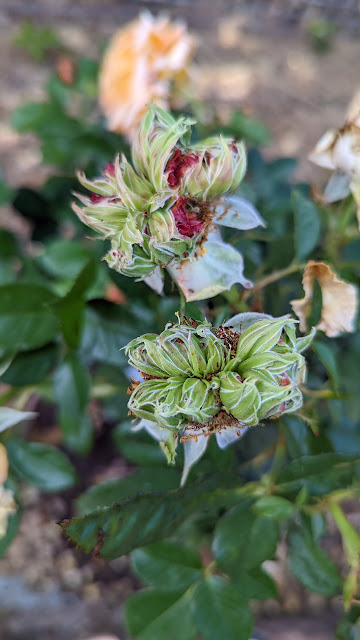
|
|
These are the weird rose buds that
prompted Kristine Castrillo's letter. The
condition is called phyllody. (Photo courtesy
Kristine Castrillo)
|
What’s wrong with my rose? If buds look like they grew in “The Little Shop of Horrors,” hormones could be the problem. But why?
A question from Kristine Castrillo of Vallejo, a regular listener to our friend Farmer Fred Hoffman’s podcast, prompted this blog post. What she saw this month on her new Forever Amber floribunda tree rose will become relatively common in Sacramento this summer. I know I will see it on my Perfect Moment; it always shows up in August.
First, here’s Kristine’s letter:
“I’m new to roses, and recently planted five rose trees in my backyard. When I went to deadhead some spent blooms, I came across a weird growth coming from the middle! My instinct is to cut it off, but my curiosity is to keep it on to see what happens.”
Kristine attached a photo and included some details about when, where and how she planted her new tree roses. That included another clue: She added fertilizer to the planting holes and top-dressed with compost. The oddball buds showed up two weeks later.
Stress from transplanting and heat probably triggered this phenomenon known as phyllody (pronounced fil-o-dee). It also can be caused by water stress (which can be aggravated by fertilizer), disease or exposure to glysophate, the active ingredient in Round-up herbicide.
A similar condition is called fasciation (like fascination with no “n”), which results in deformed growth such as fused buds and stems. It’s also probably linked to hormones during development, and affects a wide range of plants.
UC Cooperative Extension master gardeners’ plant notes, from the university’s Integrated Pest Management website, describe rose phyllody this way:
“Rose phyllody is a flower abnormality recognized for more than 200 years in which leaf-like structures replace flower organs. The fundamental cause seems to be changes in plant hormone balance, brought about by abiotic conditions such as environmental stress, or by living infectious agents. Some rose varieties such as floribundas are more likely to exhibit phyllody symptoms, probably due to genetic susceptibility.”
Viruses and disease can disrupt hormone production and cause phyllody, add the master gardeners.
“(But) in roses, the most common cause of phyllody is environmental stress, such as hot weather when flower buds are forming, or water stress,” they explain. “If environmental factors are the cause, affected plants usually have normal and abnormal flowers simultaneously but otherwise look healthy. When the weather cools, the bush resumes producing only normal flowers.”
Those super-hot days in mid-May could have triggered Kristine’s case of phyllody. If the plant didn’t get enough water to go along with that double dose of fertilizer, the rose may have experienced some water stress, too.
In my garden, some roses are more susceptible to phyllody that others. It tends to be more common in my floribundas, but my Perfect Moment (a hybrid tea) sprouts odd buds whenever we get a long stretch of triple-digit days in summer.
The solution is easy: Prune off the odd bud and let the rose sprout another one. Given enough water (and cooler days), it should look normal.
The important thing to notice is if it’s the occasional oddball bud or the whole bush. If the weird growth is just now and then, or appears on the bush at the same time as normal roses, then it’s stress-related. If it’s the whole bush and every new bud, then the condition is more serious and likely points to virus or disease.
For more on phyllody and other rose maladies:
http://ipm.ucanr.edu/PMG/PESTNOTES/pn7463.html

